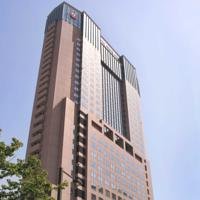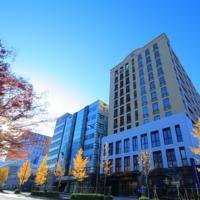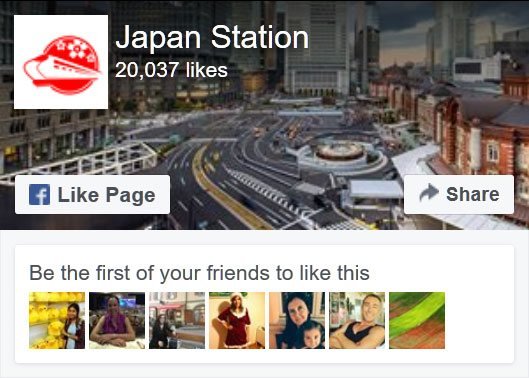The Hokuriku Shinkansen is a high speed “bullet train” rail line that runs between Kanazawa Station and Tokyo Station. It is jointly operated by JR East and JR West. Previously the line’s northern terminus was Nagano Station and it was called the Nagano Shinkansen. Since the line was extended to Kanazawa Station in March 2015, the city of Kanazawa has become an extremely popular tourist destination.
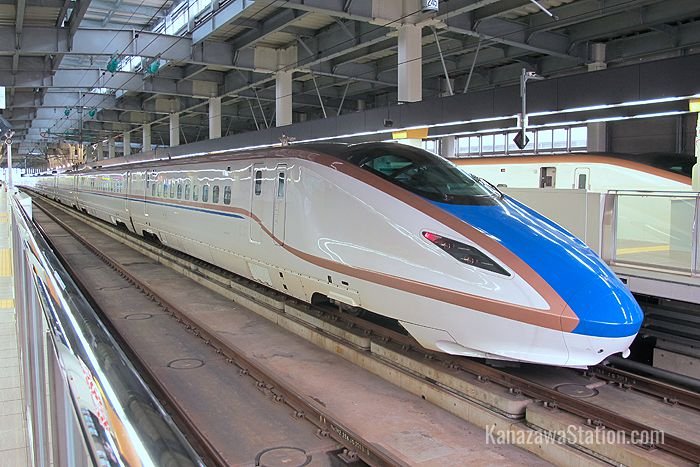
The Hokuriku Shinkansen in Kanazawa Station
Train Services
There are three shinkansen services that travel to and from Kanazawa on the Hokuriku Shinkansen line. These are the Kagayaki, the Hakutaka, and the Tsurugi. The Tsurugi is a shuttle service between Kanazawa Station and Toyama Station which takes around 20 minutes. The Hakutaka is a multi-stop service between Kanazawa and Tokyo which takes around 3 hours. The Kagayaki is a limited stop express service and has the fastest journey time between Kanazawa and Tokyo at around 2 hours and 30 minutes. In addition to these three trains there is an Asama service that runs between Nagano and Tokyo and stops at most stations on the way. All of these services are fully covered by the Japan Rail Pass.
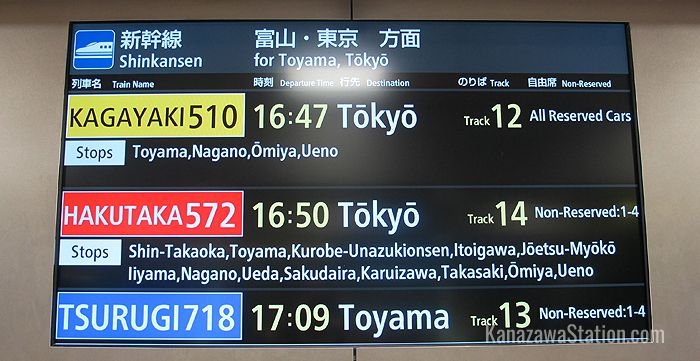
Departure times and the tracks for the three services are clearly displayed at Kanazawa Station
Key Destinations
These are the major stops of interest on the Hokuriku Shinkansen rail line. Between Kanazawa and Tokyo the Kagayaki express service usually stops only at Toyama, Nagano, Omiya, but sometimes also stops at Ueno. Non-reserved ticket fares and sample journey times are given from Kanazawa Station. Reserved tickets usually cost around 500 yen extra but this can go up and down in peak and non-peak travel periods. All seats on the Kagayaki express service are reserved.

Hokuriku Shinkansen route map
Kanazawa Station
This is the northern terminus of the Hokuriku Shinkansen rail line. Kanazawa is the capital city of Ishikawa Prefecture and a major center of both modern and traditional arts and crafts in the Hokuriku region. It’s main tourist locations include, the 21st Century Museum of Contemporary Art, the partially reconstructed Kanazawa Castle, Miyoryuji Temple (also called the Ninja Temple) which has many secret passages and trap doors, the traditional teahouses of the Higashi Chaya geisha district, and Kenrokuen garden, which is said to be one of the three great gardens of Japan.
Popular Hotels near Kanazawa Station
Shin-Takaoka Station
Shin-Takaoka Station serves the city of Takaoka; Toyama Prefecture’s second largest city. The main attractions here are the 16m high Great Buddha Statue (“Takaoka Daibutsu”), Zuiryuji Temple a designated National Treasure that dates from 1645, and the preserved wooden residences and earthern storehouses of the Kanayamachi district.
Non-reserved ticket fare from Kanazawa: 1,530 yen
Journey time on the Tsurugi: 13 minutes
Toyama Station
Toyama is the capital city of Toyama Prefecture. Its most popular tourist attractions are Toyama Castle and boat trips on the Matsukawa River. The city is also within striking distance of hiking routes along the Tateyama Mountain Range.
Non-reserved ticket fare from Kanazawa: 2,810 yen
Journey time on the Tsurugi: 23 minutes
Journey time on the Kagayaki (all seats reserved): 18 minutes
Kurobe-Unazukionsen Station
From this station you can access both the Unazuki Onsen hot spring resort and the scenic Kurobe Gorge, one of Japan’s deepest and most beautiful ravines. From Kurobe-Unazukionsen Station transfer to the nearby Shin-Kurobe Station and take a local train to Unazuki Onsen Station. The journey costs 630 yen and takes 25 minutes. Sightseeing trains for the Kurobe Gorge depart from nearby Unazuki Station.
Non-reserved ticket fare from Kanazawa: 3,500 yen
Journey time on the Hakutaka: 35 minutes
Itoigawa Station
Itoigawa is situated in a UNESCO Global Geopark and celebrates this fact with an unusual tourist information center at the Itoigawa Station. Called Itoigawa GeoStation GeoPal
Non-reserved ticket fare from Kanazawa: 4,860 yen
Journey time on the Hakutaka: 49 minutes
Joetsumyoko Station
This station serves the city of Joetsu in Niigata Prefecture. Joetsu is known for two castles: the ruins of Kasugayama Castle which date from 1573, and the partially reconstructed Takada Castle. The park around Takada Castle is famous for its cherry blossoms in the spring.
Non-reserved ticket fare from Kanazawa: 5,610 yen
Journey time on the Hakutaka: 1 hour and 2 minutes
Iiyama Station
The city of Iiyama in Nagano Prefecture has heavy winter snow fall and is nicknamed “little Kyoto of the Snow Country” because of its many shrines and temples. It is famous for its February Snow Festival.
Non-reserved ticket fare from Kanazawa: 6,590 yen
Journey time on the Hakutaka: 1 hour and 15 minutes
Nagano Station
Nagano City’s most popular attraction is Zenkoji Temple, known for its gigantic Sanmon and Niomon gates. Nagano is better known though as a jumping off point for the Japan Alps, and the popular ski resorts of Hakuba, Shiga Kogen and Nozawa Onsen (also known for its hot springs). Other nearby attractions include the town of Obuse, the former home of famed ukiyo-e painter Katsushika Hokusai, and the snow monkeys of the hot spring town Yudanaka.
Non-reserved ticket fare from Kanazawa: 8,440 yen
Journey time on the Hakutaka: 1 hour and 26 minutes
Journey time on the Kagayaki (all seats reserved): 1 hour and 5 minutes
Ueda Station
The city of Ueda is best known for Ueda Castle which dates from 1583 and is a 15 minute walk from Ueda Station. Bessho Onsen is a popular hot spring resort town just outside of Ueda City.
Non-reserved ticket fare from Kanazawa: 9,520 yen
Journey time on the Hakutaka: 1 hour and 40 minutes
Sakudaira Station
Sakudaira Station serves the city of Saku in Nagano Prefecture. This city is known for Tatsuoka Castle, an unfinished 19th century castle that was meant to be built in the shape of a 5 pointed star. It is also the site of the Usuda Star Dome, a public astronomical observatory. Every year in the first week of May, Saku City holds a colorful Hot Air Balloon Festival in which balloonists from all over Japan take part.
Non-reserved ticket fare from Kanazawa: 9,850 yen
Journey time on the Hakutaka: 1 hour and 47 minutes
Karuizawa Station
Karuizawa is an elegant mountain resort town that is popular year round because of its mild weather, but particularly in the summer when people take refuge here from Tokyo’s intense city heat. Outdoor activities include tennis, hiking, and golfing in summer and skiing and ice skating in winter. The town also has many shopping and hot spring bathing facilities.
Non-reserved ticket fare from Kanazawa: 10,920 yen
Journey time on the Hakutaka: 1 hour and 55 minutes
Takasaki Station
Exit here to visit the remaining structures of Takasaki Castle which dates from 1428, the Gunma Museum of Modern Art, and also a 41.8 meter high statue of the Goddess of Mercy called the Byakue Dai-Kannon. Takasaki is said to be the home town of the traditional “Daruma” tumbling dolls, and holds a large daruma doll market every January 6th and 7th.
Non-reserved ticket fare from Kanazawa: 11,460 yen
Journey time on the Hakutaka: 2 hours and 4 minutes
Omiya Station
Formerly a city itself, Omiya is now officially designated as a ward of Saitama City. Exit here for Omiya’s Railway Museum, the large Hikawa Shrine, which is said to date from 473 BC, Omiya Bonsai Village, which is the center of bonsai culture in Japan, and Omiya Bonsai Art Museum.
Non-reserved ticket fare from Kanazawa: 13,070 yen
Journey time on the Hakutaka: 2 hours and 30 minutes
Journey time on the Kagayaki (all seats reserved): 2 hours and 8 minutes
Ueno Station
Ueno is best known for its large park, Ueno Zoo, Tokyo National Museum, the National Museum of Western Art, and the National Museum of Nature and Science. There are also many shrines and temples in the area. For more information about Ueno area read our Ueno Station Guide.
Non-reserved ticket fare from Kanazawa: 13,390 yen
Journey time on the Hakutaka: 2 hours and 50 minutes
Journey time on the Kagayaki (all seats reserved): 2 hours and 28 minutes
Tokyo Station
Tokyo is Japan’s capital city and most populous metropolis with endless opportunities for sightseeing, shopping, dining and entertainment. Popular districts include the historic area of Asakusa, Harajuku for its pop culture and fashion boutiques, and Roppongi and Shibuya for neon-lit nightlife. The Tokyo Station Hotel offers 150 guestrooms and suites located right in the Tokyo Station Building.
Non-reserved ticket fare from Kanazawa: 13,600 yen
Journey time on the Hakutaka: 2 hours and 56 minutes
Journey time on the Kagayaki (all seats reserved): 2 hours and 33 minutes
Buying Tickets at Kanazawa Station
At Kanazawa Station you can find shinkansen ticket machines and a ticket office close by the shinkansen ticket gates. Buying your tickets at the ticket office is probably easiest as there are many different seat preferences to choose from.
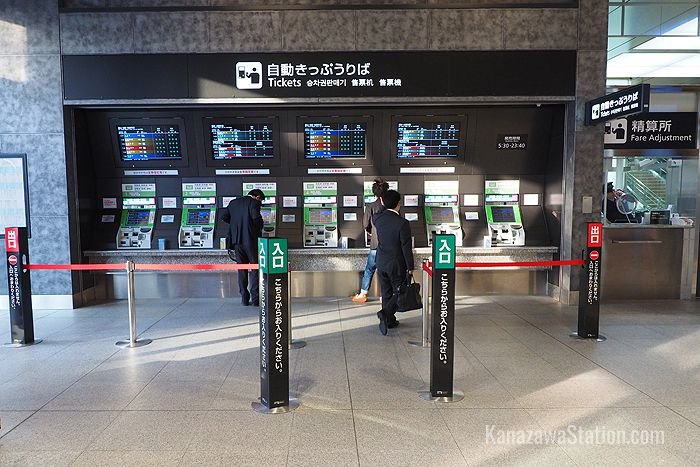
Shinkansen ticket machines at Kanazawa Station
On the Hokuriku Shinkansen there are THREE classes of ticket: Ordinary seats, Green seats (which is 1st class), and the newest luxury Gran Class seats. You can choose reserved or non-reserved seats for Ordinary cars and these seats are fairly comfortable. Tickets for the Green cars are a little more expensive and have to be reserved. Green car seats are larger and offer a little more comfort, quiet, and leg-room.
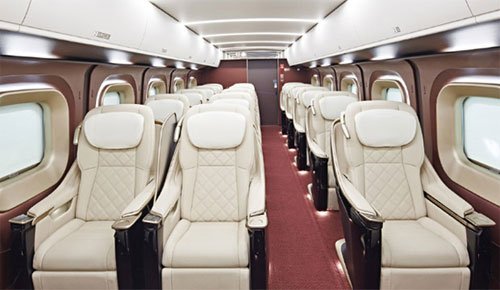
Gran class seats

Green car seats
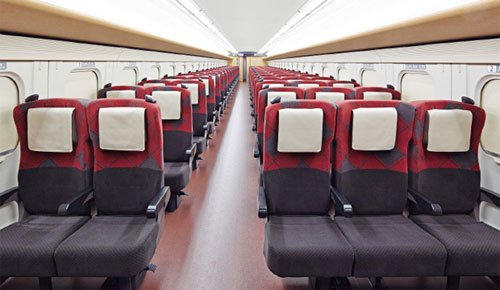
Ordinary seats on Hokuriku Shinkansen
You can use the Japan Rail Pass for either Ordinary car or Green car seats but when you buy the pass, you should choose between an Ordinary Pass or a Green Pass. Gran Class is the newest luxury class of shinkansen seating and is only available on the Tohoku Shinkansen, Hokkaido Shinkansen and Hokuriku Shinkansen. These seats must be reserved. There are only 18 seats in a Gran Class car, spaced in rows of three which makes them very spacious. The leather seats are automated and can recline up to 45 degrees. Each seat also comes with its own fold-away table, footrest, reading lamp, and call button. Attendants are on hand serving complimentary meals and drinks. Gran Class seats are not covered by the Japan Rail Pass, so you will have to pay a limited express charge and a Gran Class surcharge to enjoy this special service.
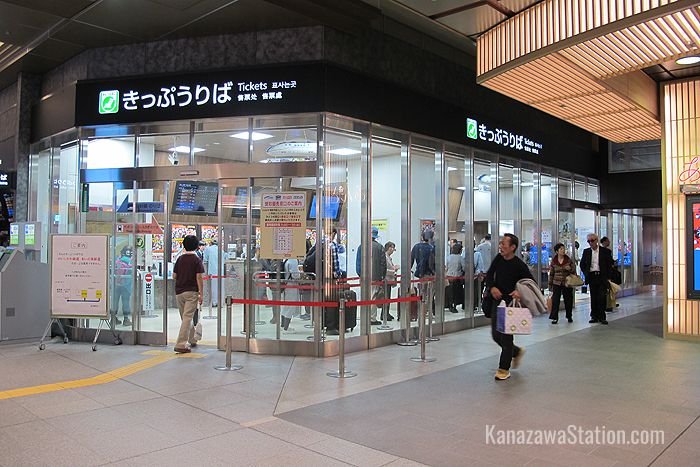
Kanazawa Station’s JR ticket office
For ordinary tickets both non-reserved (自由席 – jiyu seki) and reserved seats (指定席 – shitei seki) are usually available in separate carriages. However, on the Kagayaki express service there are no non-reserved seats, so you must reserve a seat in advance. On the Hakutaka or Tsurugi services both non-reserved and reserved seats are available. Reserved seats will cost you a little extra. However, during busy periods (particularly national holidays) the non-reserved carriages do fill up, so it may be worth making a reservation to avoid the risk of standing throughout the journey.
To summarize, when buying your tickets you will need to offer the following information:
- The number of travelers.
- The departure station and destination.
- The date and time of travel.
- One-way or return.
- Preferences: Ordinary or Green Car, Reserved or Non-reserved, Smoking or Non-smoking.
When you purchase your tickets you will receive three cards. One is your basic fare ticket (乗車券 – joshaken). You can use this ticket to pass through regular JR ticket gates. Another is your super express ticket (特急券 – tokkyuken). You will need both your basic fare ticket and super express ticket to pass through the shinkansen gates. And the third card may look like a ticket, but it is actually just a receipt. You can see a pictorial English guide to these tickets on the JR Central website. Be sure to keep all your tickets safely so you can show them to the conductor on the train.
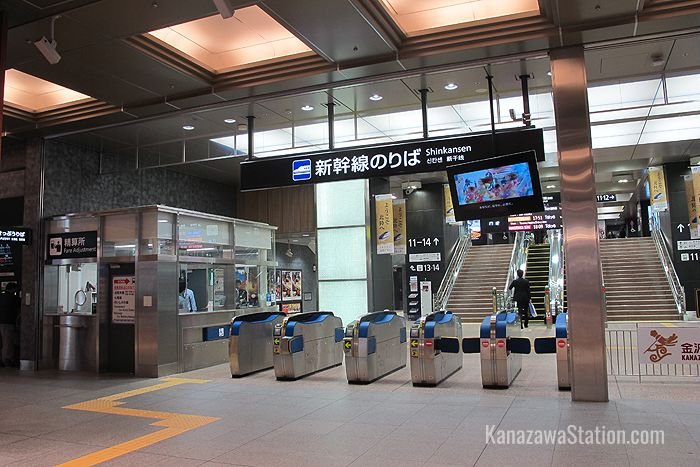
The shinkansen ticket gates at Kanazawa Station
Hokuriku Shinkansen Expansion
Work is underway to expand the Hokuriku Shinkansen line from Kanazawa Station to Fukui and Tsuruga stations by 2022. The eventual plan is to have the line continue down to Shin-Osaka Station where it will connect with the Tokaido and Sanyo shinkansen lines. However, the final route between Tsuruga and Shin-Osaka has not yet been decided.
Map & Timetables
View a complete map of Japan’s shinkansen high-speed train network.
JR East has complete timetables for Hokuriku Shinkansen trains heading to Tokyo and from Tokyo. To look up train times, fares, and connections quickly on this route use the JR West Timetable and Route Finder.
Article and original photos by Michael Lambe. All rights reserved.
